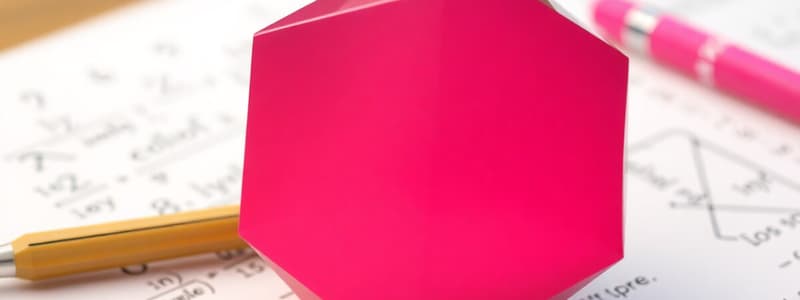Podcast
Questions and Answers
What is the study of numbers, shapes, patterns, and relationships using logical reasoning called?
What is the study of numbers, shapes, patterns, and relationships using logical reasoning called?
- Literature
- History
- Mathematics (correct)
- Biology
Which branch of mathematics deals with numbers and basic operations?
Which branch of mathematics deals with numbers and basic operations?
- Algebra
- Calculus
- Geometry
- Arithmetic (correct)
What do variables primarily represent in algebra?
What do variables primarily represent in algebra?
- Fixed values
- Geometric shapes
- Mathematical proofs
- Unknown quantities (correct)
Which field of mathematics focuses on the properties and relationships of shapes?
Which field of mathematics focuses on the properties and relationships of shapes?
What is a fundamental aspect of calculus?
What is a fundamental aspect of calculus?
Which of the following involves collecting, analyzing, and interpreting data?
Which of the following involves collecting, analyzing, and interpreting data?
What does 'probability' primarily deal with?
What does 'probability' primarily deal with?
What is a mathematical statement that asserts the equality of two expressions?
What is a mathematical statement that asserts the equality of two expressions?
Which of these is a fixed value that does not change?
Which of these is a fixed value that does not change?
In mathematical notation, what are Greek letters frequently used to represent?
In mathematical notation, what are Greek letters frequently used to represent?
Flashcards
Arithmetic
Arithmetic
Deals with numbers and basic operations like addition, subtraction, multiplication, and division.
Algebra
Algebra
Involves symbols and variables to represent quantities and relationships, enabling generalization and solving equations.
Geometry
Geometry
Studies shapes, sizes, and spatial relationships, including lines, angles, surfaces, and solids.
Trigonometry
Trigonometry
Signup and view all the flashcards
Calculus
Calculus
Signup and view all the flashcards
Statistics
Statistics
Signup and view all the flashcards
Probability
Probability
Signup and view all the flashcards
Discrete Mathematics
Discrete Mathematics
Signup and view all the flashcards
Equations
Equations
Signup and view all the flashcards
Derivatives
Derivatives
Signup and view all the flashcards
Study Notes
- Mathematics is the study of numbers, shapes, patterns, and relationships, using logical reasoning and quantitative methods
- It provides a framework for understanding the world and solving complex problems in various fields
Branches of Mathematics
- Arithmetic deals with numbers and basic operations like addition, subtraction, multiplication, and division
- Algebra involves symbols and variables to represent quantities and relationships, enabling generalization and solving equations
- Geometry studies shapes, sizes, and spatial relationships, including lines, angles, surfaces, and solids
- Trigonometry focuses on relationships between angles and sides of triangles, crucial for navigation, engineering, and physics
- Calculus explores continuous change and limits, including differentiation and integration, essential for physics, engineering, and economics
- Statistics involves collecting, analyzing, interpreting, and presenting data to make informed decisions and predictions
- Probability deals with the likelihood of events occurring, providing a framework for risk assessment and decision-making under uncertainty
- Discrete Mathematics studies discrete (distinct and separate) elements and structures, like logic, set theory, graph theory, and combinatorics, foundational to computer science
Key Concepts
- Numbers are abstract entities representing quantity. They can be natural, integer, rational, irrational, real, complex, etc.
- Variables are symbols representing unknown or changing quantities, used in algebraic expressions and equations
- Constants are fixed values that do not change within a given context
- Equations are mathematical statements asserting the equality of two expressions, solved to find the values of unknown variables
- Functions are relationships that assign a unique output to each input, represented algebraically, graphically, or in tabular form
- Limits describe the behavior of a function as its input approaches a certain value, fundamental to calculus
- Derivatives measure the instantaneous rate of change of a function, crucial for optimization and modeling
- Integrals calculate the area under a curve, used to find accumulated quantities and solve differential equations
- Proofs are logical arguments demonstrating the truth of a statement, based on axioms, definitions, and previously proven theorems
Applications of Mathematics
- Science employs mathematics for modeling physical phenomena, analyzing data, and making predictions
- Engineering relies on mathematics for designing structures, analyzing circuits, and optimizing systems
- Computer Science uses mathematics for algorithm design, data analysis, cryptography, and artificial intelligence
- Economics utilizes mathematics for modeling markets, analyzing financial data, and making predictions
- Finance employs mathematical models for pricing assets, managing risk, and making investment decisions
- Cryptography secures communications through mathematical techniques like encryption and decryption
- Statistics is used in various fields to interpret data, conduct research, and make informed decisions
- Operations Research optimizes processes, allocates resources, and improves efficiency using mathematical modeling and analysis
Mathematical Notation
- Symbols are used to represent mathematical operations, relationships, and quantities
- Common symbols include +, -, ×, ÷, =, <, >, ≤, ≥, √, Σ, ∫
- Greek letters are frequently used to represent variables, constants, or parameters (e.g., α, β, γ, θ, π)
- Mathematical expressions combine numbers, variables, and operations to represent quantities or relationships
- Equations are mathematical statements asserting the equality of two expressions
- Inequalities compare two expressions using symbols like <, >, ≤, or ≥
- Functions are denoted using notation like f(x), where f is the function name and x is the input variable
Mathematical Problem Solving
- Understanding the Problem requires reading the problem carefully, identifying key information, and defining the goal
- Devising a Plan involves selecting appropriate strategies and techniques to solve the problem
- Carrying out the Plan entails implementing the chosen strategies and performing necessary calculations
- Looking Back involves checking the solution, verifying its reasonableness, and reflecting on the process
- Common problem-solving strategies include: working backwards, looking for patterns, drawing diagrams, simplifying the problem, and using trial and error
Mathematical Theorems and Axioms
- Axioms are fundamental assumptions or statements accepted as true without proof, serving as the foundation for mathematical theories
- Theorems are statements that have been proven to be true based on axioms, definitions, and logical reasoning
- Examples of important theorems include: the Pythagorean theorem, the Fundamental Theorem of Calculus, and the Central Limit Theorem
- Theorems provide powerful tools for solving problems, making predictions, and advancing mathematical knowledge
Mathematical Modeling
- Mathematical models represent real-world phenomena using mathematical equations and relationships
- Models can be used to simulate, predict, and optimize complex systems
- The modeling process involves identifying relevant variables, formulating equations, validating the model, and interpreting results
Mathematical Logic
- Mathematical logic is the study of formal reasoning and proof techniques
- It involves using symbols and rules to represent and manipulate logical statements
- Key concepts include propositional logic, predicate logic, and quantifiers
- Mathematical logic is crucial for constructing valid arguments and verifying the correctness of mathematical proofs
Mathematical Proof Techniques
- Direct Proof: Start with assumptions and use logical deductions to arrive at the conclusion
- Proof by Contradiction: Assume the negation of the statement and show that it leads to a contradiction, implying the original statement is true
- Proof by Induction: Prove a statement for a base case and then show that if it holds for one case, it holds for the next case
- Proof by Contrapositive: Prove the equivalent statement "if not B, then not A" to prove "if A, then B"
Mathematical History
- Ancient civilizations like Egyptians and Babylonians developed early forms of mathematics for practical purposes
- Greek mathematicians like Euclid, Archimedes, and Pythagoras made significant contributions to geometry, number theory, and logic
- The development of algebra by Islamic scholars preserved and expanded upon Greek mathematical knowledge
- The invention of calculus by Newton and Leibniz revolutionized science and engineering
- Modern mathematics continues to evolve, with new theories, techniques, and applications emerging in various fields
Studying That Suits You
Use AI to generate personalized quizzes and flashcards to suit your learning preferences.




